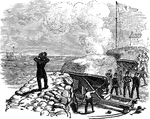
Edward Ferrero
"General Edward Ferrero was born in Granada, Spain, January 18th, 1831. His parents were Italian, and…

Fifth Corps
"The siege of Petersburg- the Fifth Corps awaiting the order to advance, July 30th, 1864."— Frank…

First Minnesota Regiment
"Fort built around the officer's quarters of the First Minnesota Regiment, Colonel Sully, near Fair…

First naval battle
"First naval battle in Hampton Roads between the Confederate iron-plated steamers Merrimac, Yorktown,…
!["First and last review of the First Regiment, South Carolina [African American] Volunteers, on Hilton Head, S. C., under Colonel Fessenden, U. S. A., June 25th, 1862. Our correspondent at Hilton Head wrote us: "I witnessed the parade entire, as well as the company drills in the manual of arms, etc., afterward, and I must acknowledge my complete surprise at the discipline and even vim evinced by the sable crowd. Dressed in the regulation uniform of the United States Army, tall and strong men generally speaking, they, considering that the regiment had not been fully armed but about ten days, spoke well for officers and men."" — Frank Leslie, 1896](https://etc.usf.edu/clipart/11000/11043/1stregiment_11043_mth.gif)
First Regiment
"First and last review of the First Regiment, South Carolina [African American] Volunteers, on Hilton…
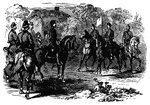
Flag of Truce
"Flag of Truce from the Confederates for a suspension of firing, to bury their dead, at Port Royal,…

Floating Battery
"Scene on the floating battery, Charleston Harbor, during the bombardment of Fort Sumter. A very important…
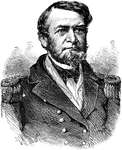
Admiral Andrew Hull Foote
Andrew Hull Foote (1806 - 1863) was an admiral in the United States Navy who served during the Civil…

Foraging spoils
"Return of a foraging party of the Twenty-fourth Regiment, Connecticut Volunteers, with their spoils,…
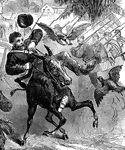
Foraging Spoils - Startled Horse
"Return of a foraging party of the Twenty-fourth Regiment, Connecticut Volunteers, with their spoils,…
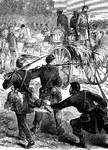
Foraging Spoils near Baton Rouge
"Return of a foraging party of the Twenty-fourth Regiment, Connecticut Volunteers, with their spoils,…
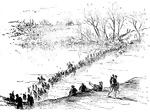
Ely's Ford
Civil War soldiers crossing Ely's Ford and the Rapidan river. Ely's Ford was a major battle of the river.…
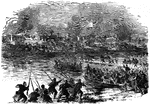
The Forlorn Hope
"'The Forlorn Hope.' Volunteers storming party, consisting of portions of the Seventh Michigan and Nineteenth…
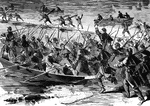
The Forlorn Hope
"'The Forlorn Hope.' Volunteers storming party, consisting of portions of the Seventh Michigan and Nineteenth…
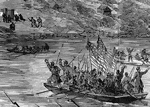
The Forlorn Hope
"'The Forlorn Hope.' Volunteers storming party, consisting of portions of the Seventh Michigan and Nineteenth…
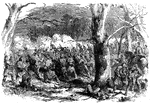
Storming of Fort Donelson
"Storming of Fort Donelson- decisive bayonet charge of the Iowa Second Regiment on the Confederate intrenchments…

Fort Fisher
"First assault upon Fort Fisher, Sunday, January 15th, 1865. The One Hundred and Seventeenth New York…

Fort Hatteras
"General view of Forts Hatters and Clark, N. C., captured on the 29th of August, 1861, by the Federal…

Bombardment of Fort Henry
"Bombardment of Fort Henry, Tennessee River, Tenn., by the Mississippi Flotilla, Flag Officer Foote,…
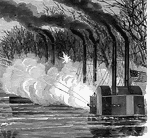
Bombardment of Fort Henry
"Bombardment of Fort Henry, Tennessee River, Tenn., by the Mississippi Flotilla, Flag Officer Foote,…

Bombardment of Fort Henry
"Bombardment of Fort Henry, Tennessee River, Tenn., by the Mississippi Flotilla, Flag Officer Foote,…
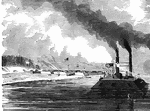
Bombardment of Fort Henry
"Bombardment of Fort Henry, Tennessee River, Tenn., by the Mississippi Flotilla, Flag Officer Foote,…

Fort Hindman
"The investment of Fort Hindman, Arkansas Post, Ark., by the Federal troops under General McClernand,…

Fort Macon
"Surrender of Fort Macon, GA., April 26th, 1862. Exterior on side facing the Federal Batteries, showing…

Fort Macon
"Surrender of Fort Macon, GA., April 26th, 1862- lowering the Confederate flag."— Frank Leslie,…

Fort Norfolk
"Old Fort Norfolk, built by the Federal government, but altered and strengthened by the Confederates."…

Fort Runyon
"Section of Fort Runyon, Va., guarding the road to Alexandria, occupied by the Twenty-first Regiment,…

Bombardment of Fort Sumter, April 12, 1861
Confederate forces bombarding Fort Sumter on April 12, 1861
Fort Taylor
"Fort Taylor, Key West, Fla. Key West, the most western of the Pine Islands, is about sixty miles southwest…

Fort Thompson
"Bombardment and capture of Fort Thompson, thirteen guns, near New Berne, on the Neuse River, by the…
Fort Vulcan
"Fort Vulcan, Jones's Island, Savannah River, Ga.- one of the Federal batteries cutting off communication…

Fort Washington
Fort Washington was the only defense that the capital had at the beginning of the Civil War.
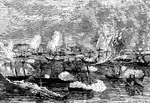
Passage of Forts Jackson and St. Phillip
Depiction of the battle on the Mississippi between Confederate and Union forces at Forts Jackson and…

General John G. Foster
"General Foster, born in Whitefield, N. H., May 27th, 1823, died in Nashua, H. H., September 2nd, 1874,…
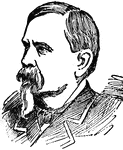
General William B. Franklin
(1823-1903) American general that served in the War with Mexico and in the Civil War.
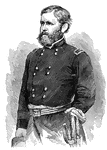
General William B. Franklin
"General William B. Franklin was a general in the Civil War."— Frank Leslie, 1896

Frederick City
"General McClellan and the Federal troops passing through Frederick City, Md., in pursuit of the Confederate…

Doubleday's Skirmishes at Fredericksburg
Abner Doubleday (1819 - 1893) was a career United States Army office and Union General in the Civil…
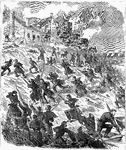
Battle of Fredericksburg
The Battle of Fredericksburg was fought in and around Fredericksburg, Virginia from December 11 to December…
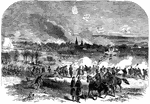
Bombardment of Fredericksburg
"Bombardment of Fredericksburg, Va., by the army of the Potomac, commanded by General Burnside, Thursday,…

Street in Fredericksburg
"A street in Fredericksburg, Va., showing the result of the bombardment- federal soldiers grouped about.…

Freemont's troops
"Gathering of Fremont's troops on the prairie, near Tipton, Mo., on the eve of its departure in pursuit…
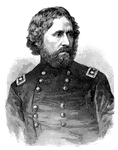
General John C. Fremont
"General John C. Fremont was head of the Western department during the Civil War."—E. Benjamin…

Front Royal
"Front Royal, Manassas Gap Railroad, Blue Ridge Mountains in the distance- the Federal army entering…

Funeral Cortege
"The funeral cortege, at boston, Mass., of the Sixth Massachusetts soldiers killed at Baltimore. The…

Battle of Gaines' Mill
The Battle of Gaines' Mill, also known as the First Battle of Cold Harbor or the Battle of Chickahominy…

Battle of Gaines's Mill
"Battle of Gaines's Mill, Friday, June 27th, 1862. At eleven o'clock each division, brigade, regiment…

Galveston
"Shelling of the batteries at Galveston by the United States war steamer South Carolina, on…

General James A. Garfield
"General James A. Garfield was the twentieth President of the United States, born in Orange, Cuyahoga…
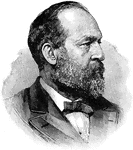
General James Abram Garfield
James Abram Garfield (1831 - 1881) was the 20th President of the United States and General of the Union…

Garibaldi Guards
"Camp of the Garibaldi Guards, Colonel D'utassy, near Roche's Mills, Va., Potomac River in the distance.…
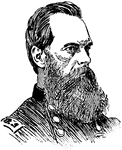
General Geary
(1815-1872) The first mayor of San Francisco and General in the Union during the Civil War.

Cavalry of General Banks
"A reconnoitring detachment of General Banks's cavalry, Hyattstown, Md., in the distance. There are…

